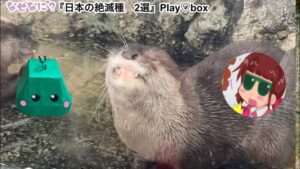
At what rate are the extinctions of living things on Earth?
Currently, there are about 1.75 million species of living creatures on Earth, and about 30 million species of living creatures including unidentified organisms. The number of species we know is about 1.75 million, and most of them are unidentified organisms. This is a surprise, isn’t it? In the era when dinosaurs existed, it is thought that one species of organism became extinct within 1000 years, but 200 ~ 300 years ago, one species became extinct in 4 years, and 100 years ago it is thought that one species became extinct in 1 year.
What is Mass Extinction ~Loss of Biodiversity~
As our lives become more convenient, many organisms are on the verge of extinction. The extinction of more than 75% of the species in the ecosystem since the birth of the earth is called “mass extinction”. Mass extinctions have occurred since ancient times due to the influence of natural phenomena, but mass extinctions caused by specific species (humans) are unusual. Mass extinctions have been recorded five times in the past, but the fifth mass extinction is a mass extinction about 65 million years ago (Cretaceous), famous for the dinosaur extinction. Since then, mass extinctions have not occurred. It is humans who can bring about or prevent the sixth mass extinction.Human beings are creatures that think. In order to correct past mistakes in the right direction, the United Nations is taking the lead in environmental conservation efforts in countries around the world. Preventing mass extinctions also leads to protecting our lives. The ecosystems that the earth has nurtured over a long period of time are gradually decreasing. The loss of biodiversity in agriculture, forestry and fisheries has many impacts on our lives, and it also leads to economic losses due to the decline of ecosystem services.
Japan’s Extinct Species “2 Selections”
This YouTube video introduced the Japanese otter and the Japanese wolf, which are famous as extinct species in Japan. I would be grateful if you could take a look.
Japanese Otter
 Before the Meiji period, Japanese otters were often seen at the water’s edges of rivers and other areas throughout Japan. It is considered to be a subspecies of the Eurasian otter, but there is an opinion that the Japanese otter is a different species and endemic to Japan due to external characteristics such as a long tail and genetic characteristics. After the Meiji period, it rapidly disappeared due to overfishing for fur. The last record of the Japanese otter (Hokkaido subspecies) was caught in the Shari River in 1955, and the last record of the Japanese otter (Honshu subspecies) was an individual found on the coast of Tomogashima in Wakayama Prefecture in 1954, and since then it has been limited to information in Shikoku, and the last record is an individual found in the Shinsho River in Suzaki City, Kochi Prefecture in 1979. And it is. The population began to decline after the Meiji period, but it is said that it is caused by excessive capture for fur purposes. Subsequently, the depletion of water resources due to deforestation and the deterioration of water quality due to river construction, pesticides, and factory wastewater during the period of high economic growth are thought to have had a major impact on the decline. It was removed from hunting in 1928 and declared a national natural monument in 1964.The following year, in 1965, it was designated as a Special Natural Monument. You can read how rapidly the decline was. In 2012, the Ministry of the Environment designated the Japanese otter as an extinct species. Even now, believing in survival, the investigation is ongoing. Stuffed Japanese otters are always on display at the Kochi Prefectural Ichi Zoological Park.
Before the Meiji period, Japanese otters were often seen at the water’s edges of rivers and other areas throughout Japan. It is considered to be a subspecies of the Eurasian otter, but there is an opinion that the Japanese otter is a different species and endemic to Japan due to external characteristics such as a long tail and genetic characteristics. After the Meiji period, it rapidly disappeared due to overfishing for fur. The last record of the Japanese otter (Hokkaido subspecies) was caught in the Shari River in 1955, and the last record of the Japanese otter (Honshu subspecies) was an individual found on the coast of Tomogashima in Wakayama Prefecture in 1954, and since then it has been limited to information in Shikoku, and the last record is an individual found in the Shinsho River in Suzaki City, Kochi Prefecture in 1979. And it is. The population began to decline after the Meiji period, but it is said that it is caused by excessive capture for fur purposes. Subsequently, the depletion of water resources due to deforestation and the deterioration of water quality due to river construction, pesticides, and factory wastewater during the period of high economic growth are thought to have had a major impact on the decline. It was removed from hunting in 1928 and declared a national natural monument in 1964.The following year, in 1965, it was designated as a Special Natural Monument. You can read how rapidly the decline was. In 2012, the Ministry of the Environment designated the Japanese otter as an extinct species. Even now, believing in survival, the investigation is ongoing. Stuffed Japanese otters are always on display at the Kochi Prefectural Ichi Zoological Park.
Japanese Wolf
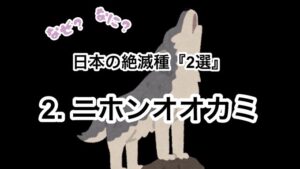 The Japanese wolf is a species endemic to Japan of the genus Canidae that lived in Japan a long time ago. It is said that it was small compared to overseas wolves and had the physique of a medium-sized dog. It is thought that the main cause of extinction is dog distemper virus infection, rabies epidemic, and pest that harms humans and livestock and has become a target for extermination. I think that the concept of wolf = evil by Western culture also influenced in no small part. After the Meiji period, it is thought that it became extinct as a result of a combination of multiple factors such as habitat loss due to human development and overfishing of herbivores that feed on it. In 1905, a young male individual captured in Nara Prefecture is considered to be the last surviving individual and is thought to have become extinct. There are only four stuffed Japanese wolves in the world: three in Japan (Wakayama Prefectural Museum of Nature (owned by the Wakayama Prefectural Museum of Education (owned by the Faculty of Education, Wakayama University), the National Museum of Nature and Science, and the Faculty of Agriculture at the University of Tokyo), and one overseas (Laiden Museum of Natural History in the Netherlands).
The Japanese wolf is a species endemic to Japan of the genus Canidae that lived in Japan a long time ago. It is said that it was small compared to overseas wolves and had the physique of a medium-sized dog. It is thought that the main cause of extinction is dog distemper virus infection, rabies epidemic, and pest that harms humans and livestock and has become a target for extermination. I think that the concept of wolf = evil by Western culture also influenced in no small part. After the Meiji period, it is thought that it became extinct as a result of a combination of multiple factors such as habitat loss due to human development and overfishing of herbivores that feed on it. In 1905, a young male individual captured in Nara Prefecture is considered to be the last surviving individual and is thought to have become extinct. There are only four stuffed Japanese wolves in the world: three in Japan (Wakayama Prefectural Museum of Nature (owned by the Wakayama Prefectural Museum of Education (owned by the Faculty of Education, Wakayama University), the National Museum of Nature and Science, and the Faculty of Agriculture at the University of Tokyo), and one overseas (Laiden Museum of Natural History in the Netherlands).
【Bonus】Is Matsutake also an endangered species?
IUCN (International Union for Conservation of Nature) designated Matsutake as an endangered species for the first time in its Red List in July 2021. The degree of risk of extinction is classified as “critical” which is the third most serious of the three levels. It is not legally binding and there are no restrictions on buying and selling. Isn’t it easy to understand if you say “urgent” like bluefin tuna in the Pacific Ocean? Matsutake mushrooms are widely distributed from Asia to Europe, but it is said that they have decreased by more than 30% in the past 50 years due to deforestation and disease. It has been pointed out that in Japan and other countries, where large quantities are harvested, pine blight damage caused by nematodes has become serious. By the way, the amount of production in Japan has not decreased by more than 30%, but has been less than 1% before the war.
prologue
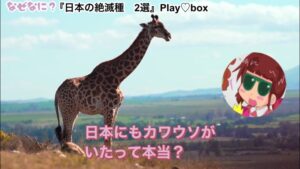 Children’s ‘Why?’ and ‘Why?’[Why what?] ] series (will it be made into a series?) The first subject is the two extinct species in Japan (Japanese otter, Japanese wolf)! There are creatures that are extinct and on the verge of extinction not only in Japan but also all over the world. There may be extinct creatures at this very moment. There is little we can do individually, but I hope it will be an opportunity to think about extinction even a little. As a companion of Spaceship Earth, let’s do what we can as individuals to protect our descendants and living creatures!
Children’s ‘Why?’ and ‘Why?’[Why what?] ] series (will it be made into a series?) The first subject is the two extinct species in Japan (Japanese otter, Japanese wolf)! There are creatures that are extinct and on the verge of extinction not only in Japan but also all over the world. There may be extinct creatures at this very moment. There is little we can do individually, but I hope it will be an opportunity to think about extinction even a little. As a companion of Spaceship Earth, let’s do what we can as individuals to protect our descendants and living creatures! 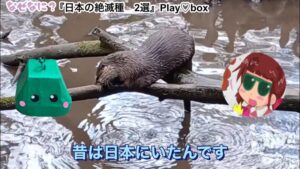
Otter loves, furari-chan and furapa ♪
At first, the tension is high.

The reality is cruel…
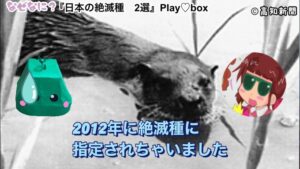
What causes extinction?
Is there anything we can do?
(* Please note that the video will emit sound)

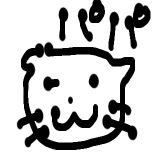


【YouTube Video】【Why?】 Japan’s Extinct Species “2 Selections” “Where did the Japanese otters go?” “
……
………………………
……………………………………………
epilogue








👆 If you don’t mind, please subscribe to the channel. 🤲
Khrapatyi (ふらぱてぃ)
Don't forget to enjoy "children's hearts"!
Let's change "boring" to "fun"!
Fun will be the sustenance of life ♡
This is a blog that focuses on child-rearing articles, YouTube video introductions, and miscellaneous articles from a professional and father's perspective by a social worker.
♥ Furari-chan (6 years old) The most beautiful girl in Japan. Gluttonous but small meal. I love cute things.
♥ Funi-kun (8 years old) A timid but kind brother. I love Pokemon.
■ Blog "Playbox ♡" (2021 / 10 ~)
Passed Google Ads examination (2022/1 ~)
■ Daughter Furari-chan and YouTube
"Play box ♡ Play box" (2021/9 ~)
Joining UUUM network (2021 / 10 ~)
Achieved 1000 registrants (2022/2)
I hope that playing with my father will lead to discoveries and learning.
Latest posts by Khrapatyi (ふらぱてぃ) (see all)
- [Why what?] Tokyo Disneyland Experience of the Corona Vortex [Closed in 2020 – Admission Restrictions] - 2023-02-11
- [Investing with parents and children! ] Results of asset management for one year with WealthNavi [2022 edition] - 2023-02-04
- [Why what?] "How much does the soul weigh?" from the theory of relativity [21 grams] - 2023-01-17
- 【Black Lotus Summary】Phantom card!? I’ll buy Black Lotus! - 2022-12-26
- [Why what?] "How to make a perpetual motion machine" that even children can understand - 2022-12-16

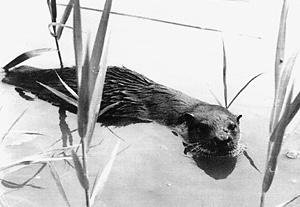


コメント